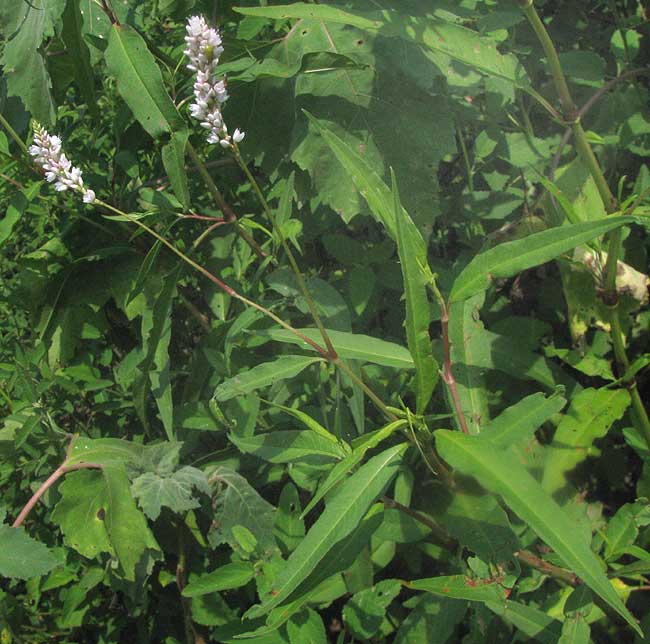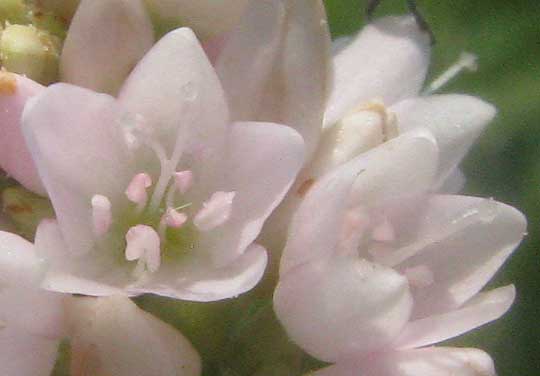Excerpts from Jim Conrad's
Naturalist Newsletter

from the the August 19, 2012 Newsletter issued from the woods of the Loess Hill Region a few miles east of Natchez, Mississippi, USA
SMARTWEED
Speaking of members of the Buckwheat Family, when I was growing up on the bottomland farm in western Kentucky back in the 50s and 60s the most commonly encountered member of that family was the knee-high weed shown above.
That's the Pennsylvania Smartweed, PERSICARIA PENSYLVANICA, and back in the 50s and 60s my father hated it because in low parts of his soybean fields where water pooled after rains, sometimes he had more smartweed than soybeans. Smartweed grew rampantly in drainage ditches and along roadsides. With the advent of the scorched-earth herbicide use we have nowadays, you seldom see the smartweed oceans we sometimes had back then. Even then I admired their vigor, and with my magnifying glass I liked nosing into its little flowers, a close-up of which one is shown below:

One flower feature seen here typical of members of the Buckwheat Family is that the white, five-lobed flowers are not differentiated into the usual green calyx and colorful corolla. Rather there's a "perianth," which is what you call the colorful part when the calyx and corolla are merged into one thing. Inside the perianth six or so stamens surround a taller, divided style, the style branches terminating with globular stigmas, where pollen is supposed to germinate.
Maybe the easiest-to-see field mark of members of the Buckwheat Family, however, is a vegetative feature, which is unusual. The stems of most Buckwheat Family members are surrounded by very conspicuous stipules where leaves attach to the stems. You can see our Smartweed's stipule below:

The online Flora of North America lists 26 Persicaria species for North America, and features of the stipule are very important in "keying out" the various species. The stipule of our Pennsylvania Smartweed is distinctive by being like a cylinder of brownish cellophane that bulges out somewhat at the base, and which at the top bears no fringe of hairs or slender spines. Without noticing these stipule features it can be hard to distinguish this species from closely related ones.
Once the flowers have set fruit you can rake the plant's spikelike inflorescence through your fingers and tiny, black, shiny, achene-type fruits will gather in the palm of your hand. Since this is the Buckwheat Family, I'll bet that if you had enough of these fruits you could grind them into a flavorful and nutritious meal, but they're so tiny that there'd be a lot of work for just a little meal. Birds, especially ducks, and other wildlife love them, though.
I read that indigenous Americans used tea made from the whole plant for diarrhea and made poultices from the leaves for piles.
Despite Pennsylvania Smartweed being so weedy, it's a native American plant occurring over most of forested North America except for western Canada and much of the northwestern US. It also extends through Mexico and Central America deep into South America.
When I was a kid I always wondered what was so smart about smartweed. Etymologists say that the name derives from the fact that smartweed juice on your skin causes it to smart -- to be irritated. However, I've never found smartweed juice to have any effect at all on my skin.